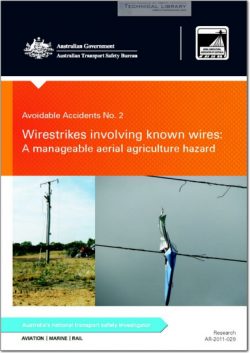ATSB-AR-2011-028
- Version
- 167 Downloads
- 6.69 MB File Size
- 1 File Count
- August 9, 2016 Create Date
- August 9, 2016 Last Updated
Avoidable Accidents No.2 - Wirestrikes Involving Known Wires; A Manageable Aerial Agriculture Hazard

In April 2009, two pilots were operating R44 helicopters spraying pine paddocks near
Langkoop, Victoria. The first paddock was sprayed in the morning for 1.5 hours before
the pilots took a 30-minute rest. From about 10 AM, the spraying of the first paddock
was completed before the pilots moved onto the second paddock. The only powerline
in the second paddock was in the north-east corner and partially crossed the paddock.
The spraying requirements, the layout of the two paddocks, and the associated hazards
were discussed between the forestry site manager and the operator's chief pilot. The
chief pilot then relayed that information to both pilots. Earlier in the day, the pilots had
discussed the difficulty of seeing the powerline. However, the accident pilot had not
highlighted the hazards on his map.
Each pilot was responsible for a portion of the paddock and spray runs followed pre—
programmed east—west—east GPS tracks. The pilot spraying the northern half of the
paddock had crossed the powerline eight times during his planned spraying. Immediately
prior to lunch, that pilot was tasked with two unplanned spray runs and then a clean—up
run in the southern half of the paddock.
Although he was now operating in a new area of the paddock, the pilot did not conduct a
reconnaissance flight to identify any hazards. The clean—up run was firstly on the western
boundary, followed by the eastern boundary travelling north. During this final run, the
helicopter collided with the powerline located in the north—east corner of the paddock.
The pilot was fatally injured.
The investigation found that an additional hazard identification check prior to the conduct
of a clean-up run (as recommended in the AAAA manual) was not routinely practiced by
all pilots or monitored by the operator.
In this case, a reconnaissance flight before the unplanned spray runs and clean-up runs could have
brought the presence of the wire back into prominence among the other considerations the pilot
may have been thinking about.
| File | Action |
|---|---|
| ATSB-AR-2011-028 Avoidable Accidents No.2 - Wirestrikes Involving Known Wires; A Manageable Aerial Agriculture Hazard.pdf | Download |

Comment On This Post